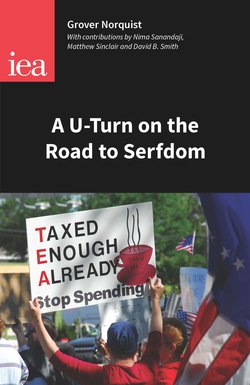Читать книгу A U-Turn on the Road to Serfdom - Grover Norquist Glenn - Страница 8
На сайте Литреса книга снята с продажи.
The ‘leave us alone’ coalition
ОглавлениеDuring Reagan’s lifetime, we did sort out the two parties along lines of principle not geography. One party largely supports reducing the size and scope of the state and increasing individual liberty. The other party tends to see human progress requiring an increasingly powerful and large government. The central issue dividing the parties is the size of the state. The Republican Party today, the Reagan Republican Party, is a collection of individuals with one thing in common: on the issue that moves their vote – not every issue, but on the issue that moves their vote – what they want from the government is simply to be left alone.
Who sits at the Republican table? Taxpayers, people who vote on the tax issue. They want the tax burden reduced. People concerned about property rights want their property rights respected. The business community – big businesses and small businesses – are not asking for special favours: they are not asking for the government to go and kneecap competitors, they just wish to be left alone (there are businesses that want the government to go and kneecap their competitors, but they bat for the other team). Around this table are also two million Americans who home-school their children. This freedom was only legalised in the past 25 years. These are people making tremendous sacrifices to give their children an education. It is a major commitment and the dominant issue in their life. They do not knock on your door and tell you that you should be a home-schooler: they simply wish to be left alone. The millions of Americans who make the sacrifice to pay for private and parochial education for their children – in addition to their taxes – also hold parental rights in education as a vote-moving political principle.
Then there is the Second Amendment community – I fully realise that nobody in Europe understands this but, in the United States, the Second Amendment, or gun rights, is a big issue. More than nine million Americans have a concealed-carry permit allowing them to carry a gun on their person. Almost twenty million Americans have hunting licences. I serve on the board of directors for the National Rifle Association, which has four million members. We don’t go around urging people to be hunters. We don’t require that all fourth-grade children be taught books in state schools entitled ‘Heather has Two Hunters’. We are simply asking to be left alone to protect ourselves and our families.
There are also members of the various communities of faith in the United States for whom the most important thing in their life is to practise their faith and to transmit it to their children. Evangelical Christians, Roman Catholics, Orthodox Jews, Muslims and Mormons hold very different views of religion, but are united in their preferred relationship with the state: they simply want to be left alone. For each group, first choice, when we were designing the Constitution, might have been: ‘make everybody be my religion’, but because we were already diverse at the beginning, the achievable second choice was ‘everybody gets left alone’.
This is an extremely important thing to understand because, sometimes when you hear the discussion in the United States, you would think that the coalition I am describing will not hold together because some of the ‘religious right’ want to impose their religious values on others. That is why you have to look at political activity in terms of vote-moving issues. The ‘religious right’ came into being in the 1970s. Why? It was because the Carter administration was going after Christian radio stations, using the ‘fairness doctrine’, a regulation originally designed to require TV and radio news to present both sides of a political issue. Christian radio viewed this as an assault on religious liberty. In addition, the Internal Revenue Service (IRS) was threatening to revoke the non-profit status of Christian schools, which were seen by the government-school teachers’ unions as a competitive threat: so these groups organised in self-defence; they wanted to be left alone; they feared state power. Understand that and you will understand why they sit at the same table and work reasonably well with people who work all day, never go to church, and simply want to pay lower taxes.
What is important is that everyone around the table wishes to be left alone on their key issue, and they vote for the same candidate. The candidate says, ‘I will leave your kids alone, your guns alone, your money alone, your property alone, your faith alone’ and he wins the votes of all these people.
Then the candidate and the party that puts itself in that position can move forward. It doesn’t mean everyone in the centre-right coalition agrees on everything: they certainly don’t. They don’t all have tea together; they don’t socialise. The guy who wants to make money all day looks across the table at the guy who wants to go to church all day and says, ‘That’s not how I spend my time.’ They both look over at the guy who wants to fondle his guns all day and say: ‘That’s not how we spend our time.’ But, for the party of liberty to advance, it is not necessary that everyone is agreed on what they would do with their liberty. It is simply necessary that we each agree on moving towards liberty.
That’s how the coalition became self-aware in time for the 1980 election. The establishment looked at it and said, ‘This will fall apart any moment,’ because they were looking at the secondary and tertiary issues on which the coalition did not agree. There you will find lots of disagreements, but on primary vote-moving issues, they are not in conflict.
